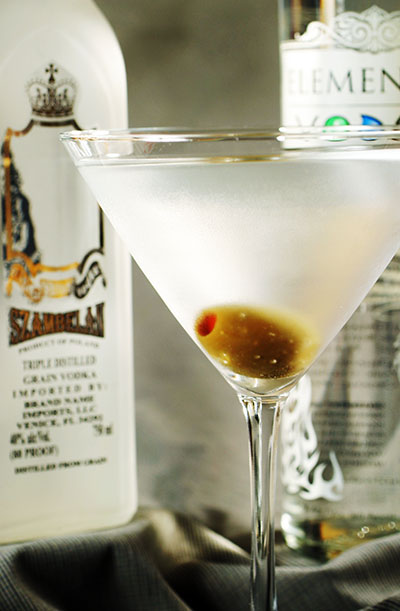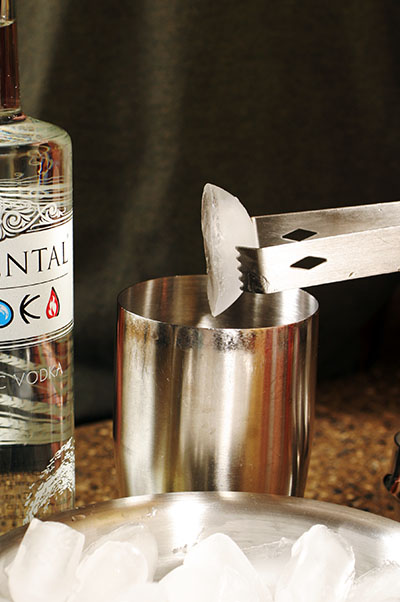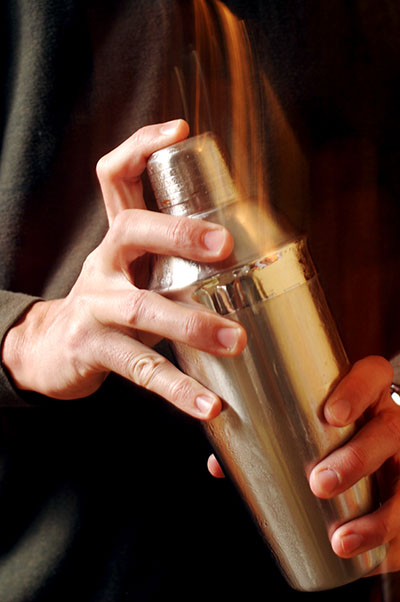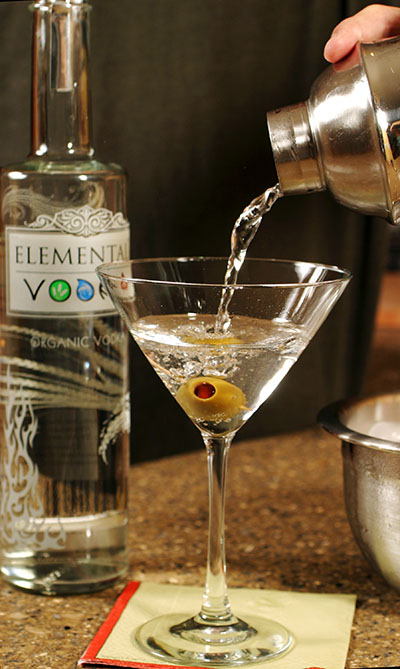Vodka Martini
Alcoholic beverages have always gone hand-in-hand with food. It may be pairing an earthy Bordeaux Graves with a perfectly seared, medium-rare buffalo steak, or it may be a quiet evening of beer and pizza. The last decade has seen a resurgence in the cocktail, both sentimentally and aesthetically. Like appetizers warming up the palate before the main, the astonishingly massive variety of mixed drinks can also be used to prepare the guest for the meal -- socially, sensually, and culturally.
One of my favorite before dinner drinks is the vodka martini. I won't pretend to be an expert, or a traditionalist. One can argue the origin, the ingredients, the tradition, the myth...but in reality, there are as many varieties of martinis as there are aficionados. Therefore, here is my personal tribute to the drink, the legend, the vodka martini.

I prefer my vodkas to be virtually tasteless. The idea is to enjoy the texture of the cocktail -- taste would be a distraction. If I want taste, I'll make a Manhattan, which is pretty much a bourbon martini.
Vodkas can't be completely tasteless, of course. Whatever base the alcohol is distilled from will come through, no matter how many times it's filtered. As most vodkas are 60% water, the water itself may have a taste, depending on the source. Since the remainder is pure alcohol, it won't be completely tasteless, either. So, what I look for is subtlety from any remaining source, along with a smooth bite free of any medicinal "rubbing alcohol" overtones, with a clean, crispness from the water.
Many vodkas, even popular ones, fail my personal quest: Absolut tastes like a hospital to me. Seagrams tastes a little like a wet brown paper bag. Level has a black peppery taste right up front that is a little too distracting. Grey Goose tastes like orange rind to me, almost overpoweringly citrus when I'm looking for something that should be more in the background.
Some vodkas come really close to the mark: Stolichnaya, the former landmark Russian vodka now involved in a territorial dispute, is nearly perfectly tasteless, though the water finish is bland almost to a hint of soapiness. Russian Standard, the latest trend out of St Petersburg, is one of my current favorites, and pretty decently priced, too. Ketel One, a little bit in the minor leagues, actually makes a pretty decent vodka, especially for the price.
I also enjoy vodkas that break my rules, and still make a fine martini. The hot Polish vodkas right now, Belvedere and Chopin, are made from rye and potatoes respectively. There's a graininess to Belvedere, and an earthy-dirt taste to Chopin, and both tastes are more assertive than I normally prefer in a vodka. Yet, the clean, crispness of the water, and the mellowness of the alcohol bite just work for me.
I recently had a chance to try three new vodkas. Szambelan, a Polish rye vodka, Primo, an Argentinian vodka made from Malbec grapes, and Elemental, a small batch, completely organic and green vodka from Portland, Oregon.
Szambelan (pronounced "zam-blan" from what I understand) is a traditional Polish vodka, very similar to Belvedere. Not too surprising, as they're both made from rye, and water pulled from artesian wells. The taste has a hint of grain, the alcohol bite is sharp but non-medicinal, and the water taste is pure and smooth. I was surprised how close it matched the other Polish vodkas, and there may be a national trend from Poland emerging, much like Russian vodkas try to establish.
Primo is a world apart. Malbec is one of the trendy grapes in red wines these days, so to make a vodka from them seems a little surprising...and yet not. This was a pretty strong grape-tasting vodka. Not as strong as an actual flavored vodka, but strong enough that the first thing I thought was -- is this a vodka or a grappa? I actually love the bitter grape skin bite of grappa, but it's not what I expected when thinking "vodka". Still, as far as trying something new goes, it'd be fun to spring this on guests during a dinner party, especially after a beef course with a Malbec wine. A Primo martini would go really well after dinner, just like a grappa.
Elemental is yet another surprise, but in a different way. Billed as a small-batch "green" vodka, it reflects our modern concern over nature, and the part we play within it. The grain is soft white wheat and is organically grown and local to Portland. The water is from the Pacific Northwest Bull Run watershed. All power for the distillery is wind generated. The vodka is filtered through charcoal and volcanic rock. Put that all together and you get the four classical elements, earth, water, wind, fire. So, yeah, gimmicky and hippy, but how does it taste? Surprisingly good, as a matter of fact. There's a distinct graininess to it, though pretty much on par with the earthiness of Chopin. The alcohol bite is very smooth, and the water is nicely crisp. The small batch nature of this vodka is pretty easy to feel through the attention of the distillers -- something you won't get from a mass-produced, robotic distillery like Absolut's. The care they place in the ingredients and setup definitely make their way through to the end product. Too often, the organic/green movement produces something long on ethics, but short on quality. Not the case with Elemental, it works.
So, here's how I make my perfect vodka martini, based on an classic martini recipe called an "in and out".

Fill a shaker 2/3rds full with ice cubes. Pour in roughly a tablespoon of dry vermouth. Make sure the vermouth is fresh! Nothing will destroy a martini more than that dusty bottle of vermouth sitting neglected for the last year. Rotate the shaker to coat the ice, then pour the vermouth right back out into the sink. There's now just enough vermouth coating the ice to take the frost off, and to amplify the vodka in much the same way salt enhances an entrée.

Pour in a generous jigger of your favorite vodka (and maybe a splash or two more). Fit the top and shake until the sides are almost too chilly to hold -- I diverge from tradition at this point, where (James Bond aside) stirred martinis are considered more clear and pure than those shaken to death. True, there are bubbles at first, and the ice does water down the drink a bit, but I will sacrifice immediate martini clarity (it clears very quickly) and alcohol strength for that amazingly wonderful layer of ice shrapnel on the top of the martini once it is poured.


Add a single, well-drained green olive, with a pimento (not bleu cheese, jalapeno, or caviar, nor excess of olive brine). Enjoy.

The vodkas listed above aren't in every spirit store, and their availability may vary from state to state, or country to country for that matter. If you're in the States or Puerto Rico, I'd like to plug one of our sponsors, A Cork Above, which not only has all three of these vodkas and more, but ships throughout the Continental US for free.



